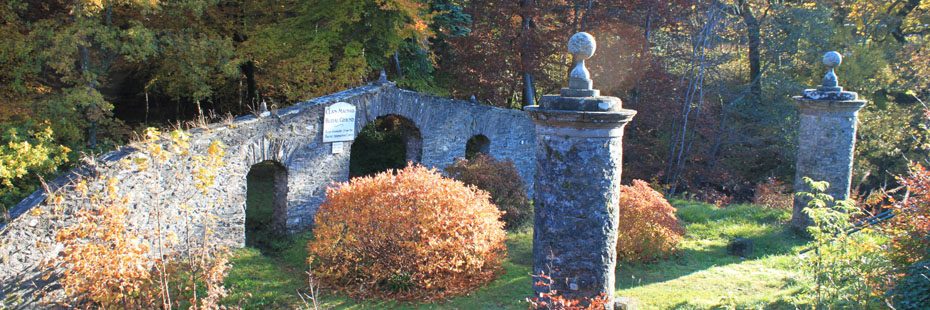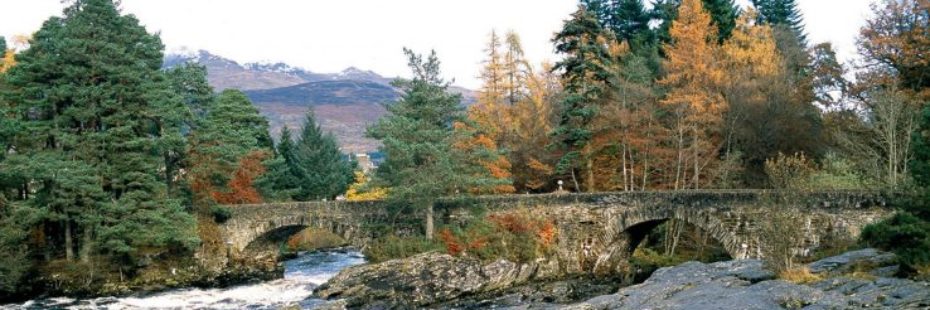
Killin
Killin is a small village at the Falls of Dochart, a spectacular series of rapids, at the western end of Loch Tay, where the Rivers Lochay and Dochart join. Killin translates as Cill Fhinn ‘the White (or Fair) Church’ in Gaelic.

Clan MacNab Burial Ground
History and heritage
The MacNab Clan were once dominant here, and have long been associated with Killin. Their ancient burial ground is on Inchbuie in the River Dochart, just below the falls, and is visible from the bridge. Kinnell House was the seat of the MacNabs. A well-preserved prehistoric stone circle known as Killin Stone Circle can be seen in the grounds of the house. To the north of the village lie the ruins of Finlarig Castle, the stronghold of the Campbells of Breadalbane, with its associated chapel. The growing power of the Campbells eventually ousted the MacNabs, who lost Kinnell House to their rivals. In 1694 Sir John Campbell of Glenorchy, 1st Earl of Breadalbane, established Killin as a Burgh of barony. In 1949 Kinnell House and its estate returned to the ownership of the Chief of Clan Macnab, but in 1978 death duties forced the then Chief, James Charles Macnab of Macnab, to sell most of the estate.
The area is valued for its historic and cultural associations. The Celtic St. Fillan founded a monastery at Kirkton and he also has strong links with Killin – it is thought he taught and preached in the village around the end of the 7th century and his healing stones are still located there.

Falls of Dochart
Falls of Dochart
Killin and the Falls of Dochart form a highlight within Breadalbane, memorable places with a strong identity in a spectacular mountain setting. The River Dochart rushes out of Glen Dochart in a series of spectacular waterfalls. The water gathers speed and falls more steeply as it heads towards Loch Tay, to become a very broad, rocky, series of rapids at Killin where it is crossed by the Bridge of Dochart. The Falls of Dochart present high drama – the all-enveloping sounds, sights, feel of the spray and smell of the waters make the falls an open-air, enveloping spectacle. Killin is dominated by the sight and the sound of the falls, a roaring backdrop to village life.
Things to do
The village makes an excellent base for walks in the surrounding mountains of Breadalbane while Loch Tay is a popular destination for both its salmon fishing and watersports. Killin sits at the edge of the Ben Lawers National Nature Reserve, providing opportunities for visitors to mix wildlife spotting, outdoor activities and walking. Close to the village centre nearby features, such as the prehistoric stone circle and medieval castle, stand witness to an old past and long history of human presence in this area. Visitors can find the ruins of the Moirlanich Longhouse, a rare surviving example of a traditional Scottish longhouse, maintained by the National Trust for Scotland.
There are a number of short walks that start from the village that let visitors explore more of Killin’s heritage:
• Historic Killin – 1½ miles (2½ km) explores the village, Finlarig Castle and Moirlanich Longhouse
• Auchmore Circuit – 2½ miles (4 km) is a circular route through the woodlands east of the village, through the old Breadalbane Estate
• Sron A’ Chlachain – 2 miles (3 km) is a steep climb up the peak (400m or 1,300ft) overlooking the village, via Fingal’s Stone
• Acharn Forest – 4 miles (6 km) a forest circular walk south west of Killin
Did you know?
Tomnadashan Mine, an abandoned copper mine east the village of Killin, is sometimes identified as the haunt of the Rabbit of Caerbannog from the popular film ‘Monty Python and the Holy Grail’.
Find out more…
- If you wish to find out more about the local Killin community and the work they do
- Visit our camping pages on Loch lubhair & Loch Dochart and the surrounding area.
- Download a copy of our SNH Landscape Assessment to learn more about the landscape of the village.

